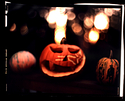I have acquired a second Holga 120N, which has a correctly-working aperture, with a third on the way, due tomorrow. Don't know if the third will also have a correctly-working aperture, or if it will be a Sunrise-made Holga, which I've read online have apertures that are backwards.
My original 120N does not have the working aperture (bought in 2007), it moves but the size of the hole is the same regardless of what the sun/cloud switch is set to. Regarding this camera, I know to use ISO 100 film on sunny days, but would it be best to use ISO 400 film on cloudy/gray days or nights, or perhaps ISO 200 on cloudy and ISO 400 during nights or gray/dark days? I would use B&W film.
Thanks..
My original 120N does not have the working aperture (bought in 2007), it moves but the size of the hole is the same regardless of what the sun/cloud switch is set to. Regarding this camera, I know to use ISO 100 film on sunny days, but would it be best to use ISO 400 film on cloudy/gray days or nights, or perhaps ISO 200 on cloudy and ISO 400 during nights or gray/dark days? I would use B&W film.
Thanks..
Last edited:





